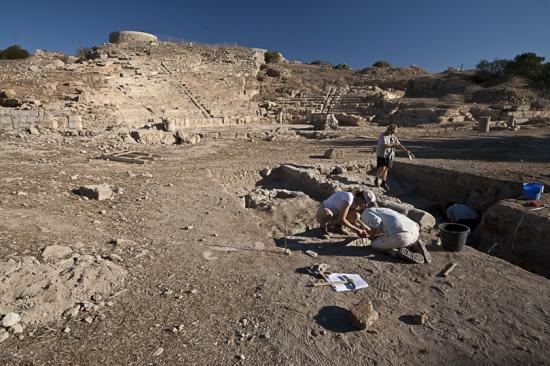|
Department of Antiquities
Source -http://www.moi.gov.cy/moi/pio/pio.nsf/All/F9184B7E6CF65B0DC22579E3003E6FAC?OpenDocument

The Ministry of Communications and Works, Department of Antiquities, announces the completion of the fourth excavation season of the French Archaeological Mission, directed by Dr. Claire Balandier, Professor of Ancient History and Archaeology at the University of Avignon, France, which was conducted from June 8 to July 10 2011 on the “Fabrika” hill in Nea Pafos.
During this season the excavations continued north (site A) and south-east (site B) of the previously excavated areas.
To the north, the excavations continued in the building, which was partly excavated during the 2010 season. The room to the south was completely excavated and its foundations were located at a depth of more than 4 m. Although the stratigraphy is still under study, material dating to the 2nd and 1st century B.C. was uncovered in its foundations, whereas the destruction layer most likely dates to the 1st century A.D.
The destruction layer was completely excavated at the room to the east. Two pillars delineate a wall that divided the room in two areas linked by an opening in the wall. The southernmost area appears to have been abandoned in the 1st century A.D. The building continued to be operational, but in a more confined space.
Numerous fragments of wall paintings have been unearthed and restored by conservators of the Department of Antiquities.
To the southeast, the cistern has been fully excavated and a system of carved channels in the rock has been uncovered. These channels were related to the water pipe system (ceramic pipes) that led to the underground aqueduct excavated in 2010 and subsequently to the theatre.
An important cluster of ceramics was excavated on the slope of the hill. Several pitchers of the Roman period with calcareous concretions indicate a prolonged stay in the water. These ceramics were most likely found in the bottom of the nearby cistern, and were moved to the hill in the 13th century when the cistern was cleared to be reused. This is also attested by the blocks of the cistern associated with the ceramic cluster.
The “Fabrika” hill appears to have been inhabited as early as the end of the Hellenistic period and occupied through the Roman times. It is not clear when the area was abandoned. No evidence of Byzantine occupation has survived; however, there is material evidence that the hill was partially reoccupied during the Frankish period.
In addition to the above excavations, the French mission has begun to inventory and study the underground quarries at the “Fabrika” hill, which were probably used in the Hellenistic period. The quarries’ extraction phases and methodology are exceptional and can be compared to those of Syracuse and Petra.
|